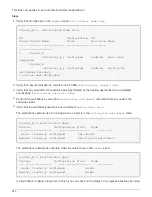
• The
replacement
node is the new node that replaced the impaired node as part of this procedure.
• The
healthy
node is the HA partner of the
replacement
node.
Steps
1. If the
replacement
node is not at the LOADER prompt, halt the system to the LOADER prompt.
2. On the
healthy
node, check the system time:
show date
The date and time are given in GMT.
3. At the LOADER prompt, check the date and time on the
replacement
node:
show date
The date and time are given in GMT.
4. If necessary, set the date in GMT on the replacement node:
set date
mm/dd/yyyy
5. If necessary, set the time in GMT on the replacement node:
set time
hh:mm:ss
6. At the LOADER prompt, confirm the date and time on the
replacement
node:
show date
The date and time are given in GMT.
Step 2: Verify and set the HA state of the controller module
You must verify the
HA
state of the controller module and, if necessary, update the state to match your system
configuration.
1. In Maintenance mode from the new controller module, verify that all components display the same
HA
state:
ha-config show
The HA state should be the same for all components.
2. If the displayed system state of the controller module does not match your system configuration, set the
HA
state for the controller module:
ha-config modify controller ha-state
The value for HA-state can be one of the following:
◦
ha
◦
mcc
◦
mcc-2n
◦
mccip
◦
non-ha
3. If the displayed system state of the controller module does not match your system configuration, set the
HA
state for the controller module:
ha-config modify controller ha-state
4. Confirm that the setting has changed:
ha-config show
Step 3: Run system-level diagnostics
You should run comprehensive or focused diagnostic tests for specific components and subsystems whenever
you replace the controller.
369
















































